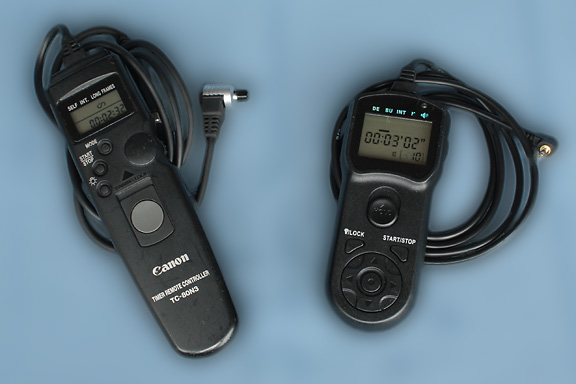A remote release is a special shutter release with a button on the end of a wire that plugs into your camera and lets you open the shutter without touching the camera.
The shutter will stay open as long as the button is pushed, or locked down. This allows the exposure to be started without touching the camera, to reduce vibration and possible movement when the shutter is opened or closed which can cause blurred or trailed pictures.
If you are just going to take a couple of pictures, you don't really need a remote release. You can just use the self-timer built into the camera.
If you are going to take a lot of pictures, or one day plan to use the advanced technique of shooting a lot of frames to stack to improve your images, you might want to get a remote release timer / intervalometer.
Remote Release Camera Plugs
Professional and prosumer cameras from Nikon and Canon require proprietary plugs for their remote releases.
Less expensive consumer models, such as the 1000D (Digital Rebel XS) and the XTi (450D), take a simple mini-stereo plug.
Remote Release Switch
- Canon RS60-E3 for 300D, 350D, 400D, 450D, 500D, 550D, 600D, 60D Canon EOS DSLR Cameras
- Canon RS80-N3 for EOS 10D, 20D, 1D, 30D, 40D, 50D, etc.
- Nikon ML-L3 Infra-red trigger for the D50, D70, D40 etc.
- Nikon Nikon MC-DC2 remote release for D90, D3100, D5000 and D7000 Nikon Cameras
- Nikon MC-30 Remote Trigger Cord for Nikon D1, D2, D3, D3X, D3S, D300S, D700, D200, D300, D700 cameras
Homemade Remote Release
You can even make your own remote release if you are knowledgeable about electronics and handy with a soldering iron and can obtain the correct kind of plug.
- Canon: Three wires control the camera: the black ground wire, the white focus wire, and the red shutter release wire. The focus wire must be shorted to ground first, then the shutter wire, to fire the camera. You can find instructions to make your own Canon switch here.
- Nikon: Three wires control the camera: the yellow ground wire, the white wakeup wire, and the purple shutter release wire. You can short the white wakeup to ground first and then the purple shutter release, or you can short white and purple to yellow ground at the same time, but you can not short the release first. You can find instructions to make your own Nikon switch here.
Personally, I would recommend that you spend a little more and get a remote release timer like one of those below. A remote switch is ok for opening the shutter for a couple of frames, but once you get serious you will want to shoot a lot more frames and doing this manually for every frame will quickly grow tiring.
Remote Release Intervalometer Timer
A remote release intervalometer timer is a neat little device that basically incorporates a timer and control circuitry that lets you take a certain number of images, each of a certain length exposure, each at a fixed interval. For example, you can take 10 frames, with each exposure being 2 minutes long, with a break of 10 seconds in between each frame. Each parameter can be changed.

|
|
Canon's TC80-N3 Remote Release Timer (left), and JCC's Remote Release Timer (right) can be used to automate an imaging session.
|
This is also a great way to do time-lapse photography with your DSLR camera. Some high-end Nikon DSLRs have this feature built into the camera, but Canons don't. You can program an exposure sequence and control a Canon camera with software that comes with the camera, but then you need a computer to run it.
Canon makes the venerable TC-80N3 and Nikon the MC-36. Both are expensive. Much less expensive Chinese remote timer release intervalometers can be found on Ebay.
- JCC Timer Remote Control for Canon consumer cameras. DSLRbaby also has models for most other DSLR cameras.
- HK Supplies also makes inexpensive timer remote controls available through Hong Kong Supplies on Ebay for Nikon or Canon cameras.
- Canon TC-80N3 for the Canon 1D, 10D, 20D, etc.
- Nikon MC-36 Remote Trigger with timer for F5, F100, N90S, D1, D2H, etc.
- Gerald Wechselberger offers an adapter for the TC-80N3 to use with the Canon E3 plug cameras (Canon 350D, 400D, 450D, 500D, 550D, 600D, 1000D, 1100D, 60D etc.) without changing the plug on the end of the TC-80N3 which is made for the Canon 20D, 30D, 40D, 50D series.
- Hap Griffin offers a stereo plug adaptation spliced into the cable of a TC-80N3 so the timer can be used with different cameras, or an extension cable used.
- DSLRStar - DSLRStar is a special hardware/software device made by Cercis Astro for controlling long exposures with Canon DSLR cameras for astrophotography. It can work as a stand-alone device for control of the camera in the field without a computer, or it can interface between a computer and the DSLR camera body. DSLRStar will automate exposure sequences including type, duration, delay between exposures and mirror lockup use. DSLRStar also stores information about the exposure, such as type, duration, time, date and temperature in its non-volatile memory. This information can be synchronized later with the exposures. With a built-in temperature sensor it can automate the capture of dark frames, taking darks within a specified temperature range.
|
Remote Releases - The Bottom Line
If you are going to be shooting more than a couple of frames at a time, then a remote release timer can be a great convenience. It will allow you to shoot many frames automatically with the camera unattended.
|
|